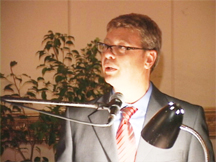-US$257M allocated to agriculture
Since beginning a partnership with Guyana in 1977, the Inter-American Development Bank (IDB) has granted the country in excess of 58 loans valued at more than US$1billion, a recent report released by the IDB’s country office says.

The report titled “Guyana and the IDB: Partners for Progress” was officially launched last evening at a reception held at the Pegasus Hotel to celebrate the 50th Anniversary since the Bank’s formation.
According to the report, from 1977 to this year the IDB has lent Guyana a total of $1,056,109,000, with the Agriculture Sector benefitting the most from these loans. Over the years, this sector has received US$ 257,347,000 in funds from the IDB, which represents 24.4 percent of the overall sum granted in loans. The transportation sector has benefitted from loans to the tune of $184,668,000, 17.5 percent of the total amount, while 10.4 percent of the loan funds, which amounted to $109,773,000, was disbursed to the energy sector. The education sector received US$ 90,049,000 from the IDB, which represents 8.5 percent of the total amount disbursed in loans.
Significantly, over the last three years, urban development was the category that has received the most money from the IDB in loans. US$27,900,000 has been allocated to this sector during this period, out of a total of US$74,281,000, which was granted to this sector. And since 2006-2009, the Agricultural Sector received US$20,900,000 in loans, while US$20,570,000 was loaned to projects related to the Environment and Natural Resources. In this period, the Transportation sector benefitted from US $24,300,000 in loans while $19,800,000 was granted in loans under the category “Social Investment”.

Meanwhile, during this period Guyana has also benefitted significantly from IDB grants with a total of US$ 67,709,000 being given in Technical co-operation funds. US$14,953,000, which represents 22.1 percent of the total amount given in grants, has been dedicated to the Reform and Modernization of the State. Since 2006, US $2,504,000 has been dedicated for this cause. Over this period sums of US$1,872,000 and US$ 1,638,000 have been given in grants for the development of Small and Medium Size Enterprises and Social Investment respectively.
“Technical co-operation (TC) funds are used for institutional strengthening, knowledge transfer, and diagnostic , pre-investment, and sector studies to support project design or preparation”, the report explains. According to the report, these funds are drawn from several sources including the Fund for Special Operations (FSO), Development Trust Funds (DTF), the Multi-lateral Investment Fund (MIF) and Ordinary Capital (OC). The Energy, Transportation and Health sectors have benefitted from grants to the value of US$ 926,000, US$900,000 and US$875,000 respectively.
The report notes that from 1997 to now, the FSO has provided more than half of the total resources dedicated to Technical co-operation in the country. “DTFs, which are used in particular to enlist consultants with technical expertise and form partnerships, provided about 30 percent of technical assistance with MIF and OC resources filling the remaining gap”, the report says.
The report also notes the US$356 million which the country was granted in debt relief in May 2007 within the context of the Multilateral Debt Relief Initiative (MDRI). According to the report the country had carried a large stock of debt from the 1970s and 1980s, during which time market prices declined on the nationalized products, while it spending remained high. The Government financed its deficits with external borrowing which led to unmanageable external debt-to-GDP levels.According to the report “the stock of public and publicly guaranteed external debt stood at around US$1 billion at the end of 2006”. Following the debt-write off Guyana’s external debt-to GDP ratio declined to 72.4 percent by December 2007.
Limited Corruption
Meanwhile IDB Country Representative Marco Nicola recently told Stabroek News that the funds being provided to the country is testimony of a healthy partnership between the Bank and the Government of Guyana. While saying that there was little evidence of corruption on the part of the government, he did admit that “the current loan repayment is quite low”.
Asked if the IDB had any concerns about corruption in Guyana, Nicola said that it was not a cause for widespread concern.
The country representative said that he has read about corruption or about perception of corruption in the newspapers and opined that “every country has the same concern when money is involved…”. Nicola, however, said that from his experience local corruption relating to the use of IDB funds was not commonplace: “I’ve been in Guyana quite a lot….and whatever was detected was dealt with”. According to him, there was one local incident of corruption back in the early part of the decade but this was addressed and corrected. Nicola said he was unable to recall what this incident was about.
Nicola said that in order to reduce corruption, specific audits are conducted in the country every three years, where the internal practices at the country office are examined. He also said that the procurement processes, financial management, disbursement practices within the country would be examined.
Meanwhile, quizzed about the recent announcement by the IDB that it will be helping countries reduce corruption by overhauling the anti-corruption framework, Nicola said that transparency and anti-corruption were two important issues for the Bank.
He pointed out that the Office for Institutional Integrity has been in place since the early 2000s.
He said that is why the IDB keeps improving its framework in order to avoid corrupt practices both internally and with their clients. The new system seeks to ensure that there is transparency in the various country offices and that the workers follow the rules. When it comes to the clients, the new system seeks to ensure that the money assigned for projects is properly.
According to the Country Representative, officials attached to the anti-corruption department of the IDB will most likely be travelling to the country sometime next year to explain the new system to the government, members of civil society as well as to the staff.
